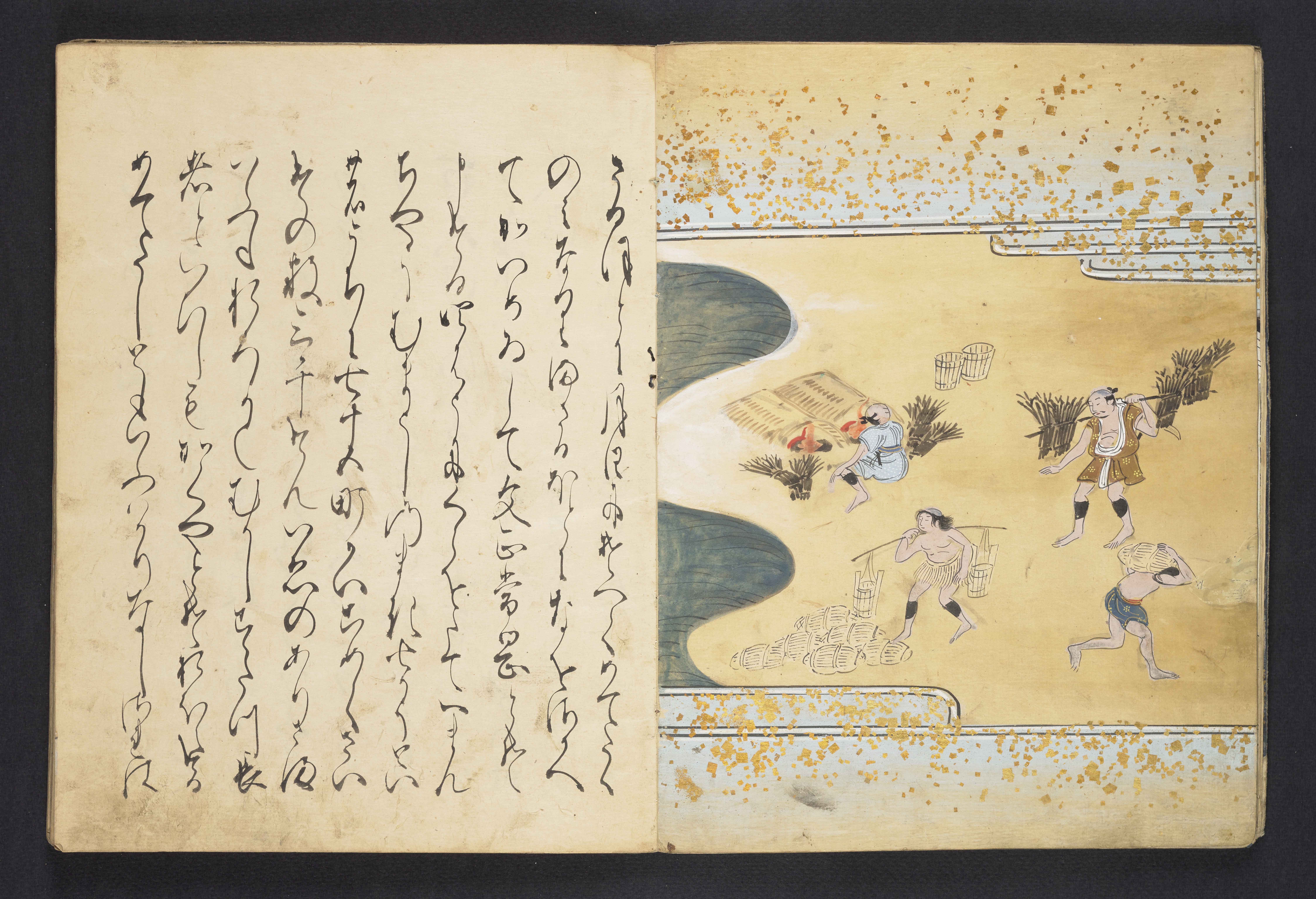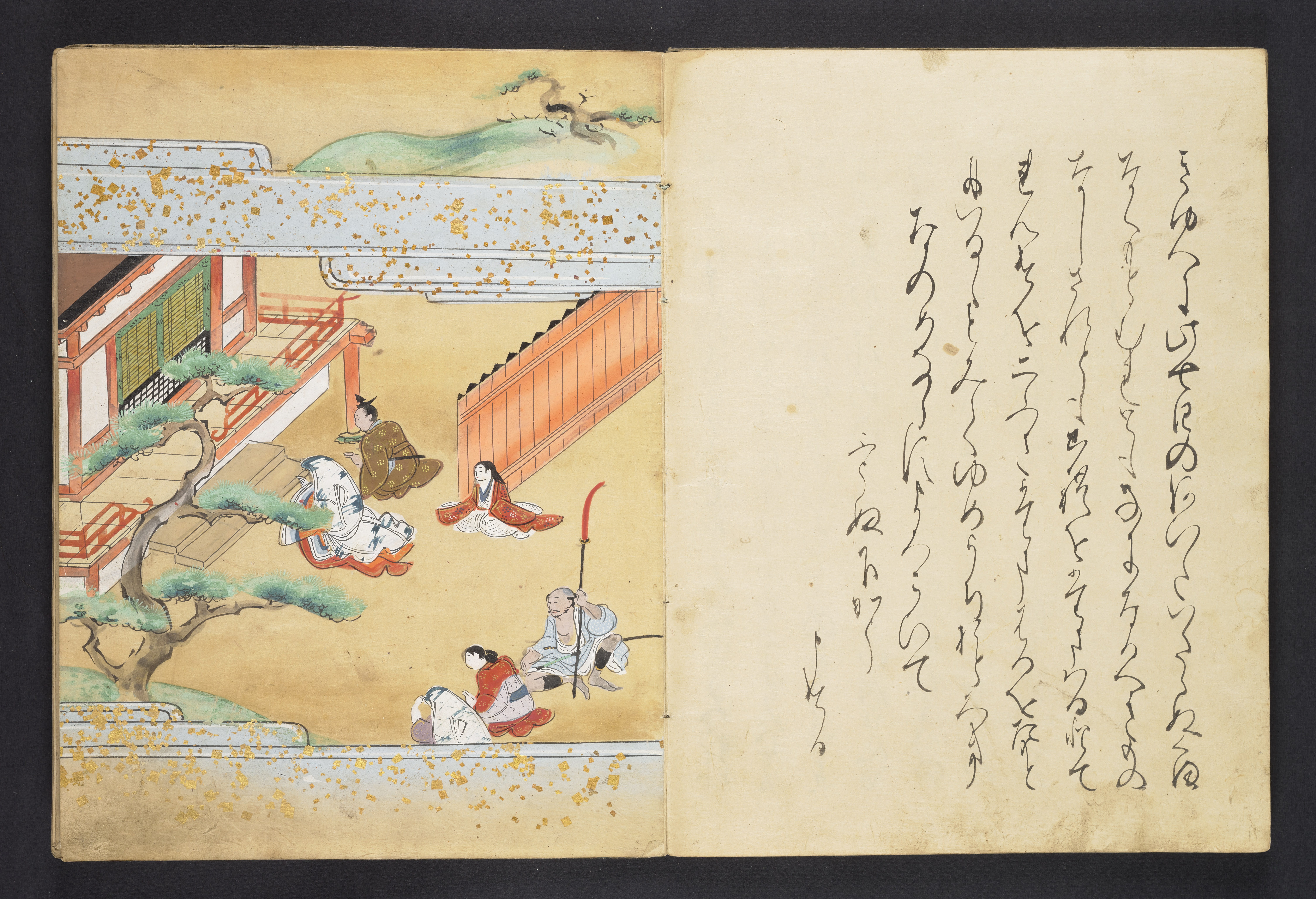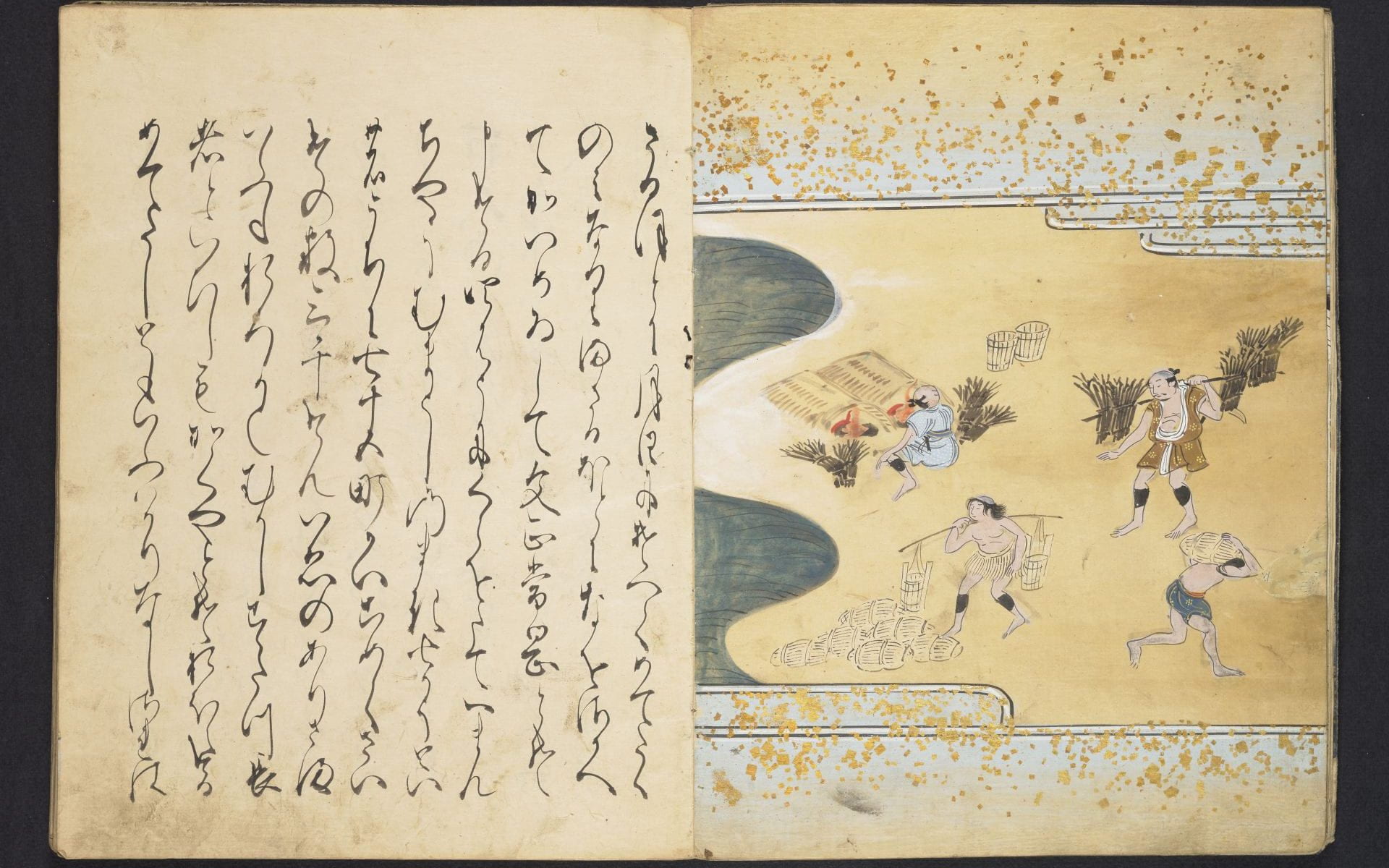
Artist: Tosa School, style of
Title: Bunshō ぶんせう (Bunsho)
Date: 17th century
Medium: Manuscript: ink, color, and gold on paper
Size: 23.8 x 17.6 cm
Gift of Arthur Tress, Arthur Tress Collection of Japanese Illustrated Books
Tosa School 1, Kislak Center for Special Collections
When is a book an event? For a period in early nineteenth-century Japan, the New Year was a time for fresh installments of the phenomenal Nise Murasaki Inaka Genji. Even earlier the ritual reading of lavish hand-copied productions of an auspicious tale had marked this most important holiday. Colorfully illustrated, they told of the miraculous rise in fortunes of a common salt maker named Bunda.
The Tress Collection contains a single volume of Bunshō sōshi, or “The Story of Bunshō,” bearing the simple title Bunshō. (Bunda upgrades his name to Bunshō in accordance with the abundant wealth he earns after coming in to his own making salt that keeps people young and healthful.) Thirty openings beautifully render the life of this honest, pious, and hard-working man (second illustration) and, perhaps more importantly, his daughters. For it was the daughters of merchant families who read–or had read to them–this tale on the second day of the lunar new year in the hopes of happy and prosperous futures.
Imagine the scene: among your tasks as the old year ends is to order a copy of the story with elegant calligraphy for the text and familiar but grand versions of the expected illustrations. The workshop that produces the books, hoping to maximize profits and avoid the crush of orders before the holiday, puts together an assembly line with artisans responsible for paintings, for text, for covers. All must be fit together, attractively and with no waste. The Tress manuscript demonstrates this reality while also relating how prayers to the Kashima Shrine in Hitachi province (shown in the third illustration) resulted in the birth to Bunshō’s wife of two girls. They were of such perfection that their hands in marriage were sought by a courtier from the capital and even the sovereign. First, however, as the pictures show us, the daughters steadfastly resisted the suits of a local governor, the Kashima priests’ sons, and local lords.

Many copies of Bunshō sōshi survive (in excess of eighty), but their artists are anonymous, just like the author of the story itself. Short or mid-length narratives in this vein are sometimes known as Muromachi monogatari, tales from the high medieval era, or otogi zōshi, “companion tales,” a name that derives from a collection published in the early eighteenth century, Otogi bunko. More than four hundred such tales, dating from the early fourteenth to the early seventeenth century, have come down to us, but Bunshō sōshi was first in the Otogi bunko selection. The format is often referred to as Nara ehon, “Nara picture books,” a misnomer because they were not produced in the city of Nara. Typically it indicates a medium-sized booklet, bound with thread and sporting indigo covers (although some are in scroll format). The covers have delicate floral motifs in gold, the dark and light combination imitating the decoration for the highest class of Buddhist scriptures.
The Tress text holds few surprises, differing from a popular recension by minor variations. The pictures, five interspersed among pages of flowing brushwork, are delightful but usual. Only the painting of Bunda making salt is not always found in manuscripts. It is hard to date or place the Tress copy relative to other versions, some of which elaborate different aspects of the story. The reverse sides of some pages have their secrets, however. On the back of the fourth illustration, we can see a basic ink sketch of the daughters who are finely finished on the front in polychrome. The front and back covers are lined with reused paper, fragments of what appear to be correspondence. More oddly, the first page of our book is a superfluous copy of a page in the middle of the story—the extra page corresponds to the left side of the eleventh opening, although it uses different character variants, and has almost twice as much text on it as the corresponding main page. Someone has brushed a large “X” through this “first” page, so originally it too was no doubt pasted down, its blank back forming the inside of the front cover. We cannot be sure how many pages or volumes are missing from our copy. The front cover has a cartouche with the title written in nonstandard characters, as well as “first volume.” It is possible that there were two more; certainly there was a second volume.
Among other surprises about these hand-painted and brush-written tales, many were copied from printed editions. We often assume that the advent of print culture to Japan in the late sixteenth century meant the end of the manuscript, but such is not the case. Printed books imitated the free and personalized style of manuscript, while some manuscripts used well-done printed editions as models.
Selected Readings
Araki, James T., trans. “Bunshō Sōshi: The Tale of Bunshō, the Saltmaker.” Monumenta Nipponica vol. 38, no. 3 (Autumn, 1983): 221-49.
Keene, Donald. “Muromachi Fiction: Otogi-zōshi.” In Seeds in the Heart: Japanese Literature form Earliest Times to the Late Sixteenth Century, 1092-1128. New York: Henry Holt and Company, 1993.
Marra, Michele. “Economic Success and Aristocratic Legitimation: ‘The Story of Bunshō’.” In Representations of Power, 140-43. Honolulu: University of Hawaii Press, 1993.
Ruch, Barbara. “Medieval Jongleurs and the Making of Japan’s National Literature.” In Japan in the Muromachi Age, edited by John W. Hall and Takeshi Toyoda, 279-309. Berkeley, Los Angeles, and London: University of California Press, 1977.
Shirane, Haruo. “Muromachi Tales (Otogi-zōshi).” In Traditional Japanese Literature: An Anthology, Beginnings to 1600, 1097-1100. New York: Columbia University Press, 2007.
Written by Linda H. Chance
Posted April 6, 2022

